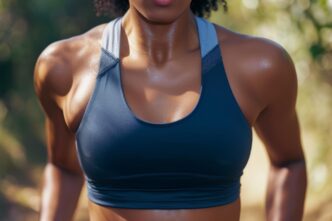A Quick Takeaway
The Story Behind the Trend
How to Make It Work for You
The Community View
For runners of all levels, from casual joggers to marathon enthusiasts, selecting the right sports bra is not just about comfort; it is a critical component for performance, injury prevention, and overall enjoyment of every stride. A well-fitted, supportive sports bra minimizes breast movement, reduces discomfort, and protects delicate breast tissue during high-impact activities, ensuring you can conquer any workout, anywhere, with confidence and focus.
Why the Right Sports Bra is Non-Negotiable for Runners
Running is a high-impact activity that places significant stress on the body, especially the breasts. Without adequate support, the repetitive up-and-down motion can lead to pain, discomfort, and even long-term tissue damage, including stretching of the Cooper’s ligaments, which are responsible for maintaining breast shape. Investing in a high-quality sports bra specifically designed for running is therefore paramount for female athletes.
Beyond physical comfort, a proper sports bra also contributes to improved running mechanics. When discomfort is minimized, runners can maintain better posture, breathe more effectively, and focus on their form rather than being distracted by pain or inadequate support. This translates directly into more efficient and enjoyable training sessions.
Understanding Support Levels: Matching Your Bra to Your Run
Sports bras typically come in three main support levels: low, medium, and high impact. For runners, high-impact support is almost always the best choice due to the intense, repetitive motion involved in the sport. However, understanding the distinctions can help you make an informed decision for different types of workouts.
Low-Impact Support
Low-impact bras are suitable for activities like yoga, walking, or strength training where breast movement is minimal. They offer light compression and often feature thinner straps and less structured designs. These are generally not appropriate for running.
Medium-Impact Support
Medium-impact bras provide more support than low-impact options, ideal for activities such as cycling, brisk walking, or elliptical training. They offer moderate compression and may have slightly wider straps or a more robust underband. While an improvement, they still may not provide sufficient support for serious running.
High-Impact Support
High-impact sports bras are engineered to significantly reduce breast movement during vigorous activities like running, HIIT, or jumping. They feature strong compression or encapsulation (or both), wide, padded straps, and a firm underband to anchor the bra securely. This level of support is essential for runners to prevent discomfort and potential tissue damage.
Key Features to Look for in a Running Sports Bra
When selecting a sports bra for running, several design elements contribute to its effectiveness and comfort. Paying attention to these features can help you find your perfect match.
Fabric Technology
Opt for bras made from moisture-wicking, breathable fabrics like polyester, nylon, or blends with spandex. These materials draw sweat away from the skin, keeping you dry and comfortable, and preventing chafing. Mesh panels are often incorporated in high-heat areas for enhanced ventilation.
Strap Design
Strap design is crucial for distributing weight and preventing shoulder digging. Racerback styles offer excellent support and freedom of movement for the arms, making them popular among runners. Cross-back or adjustable straps provide customization for a personalized fit. Wider, padded straps are always preferable for high-impact activities to minimize pressure points.
Underband Firmness
The underband is the foundation of any supportive sports bra; it should fit snugly and lie flat against your rib cage without digging in or riding up. A wide, firm underband provides the majority of the bra’s support, anchoring it in place and preventing excessive bounce. It should be comfortable enough to wear for long periods but tight enough to feel secure.
Cup Construction: Encapsulation vs. Compression
Sports bras typically use either compression, encapsulation, or a combination of both. Compression bras press the breasts against the chest wall to minimize movement, often seen in pullover styles. Encapsulation bras feature individual cups that separate and support each breast, similar to a regular bra, offering a more natural shape and often superior support for larger cup sizes. Many high-impact running bras combine these methods for optimal support.
Closure Type
While pullover styles are common, hook-and-eye closures (like those on traditional bras) offer adjustability and can make the bra easier to get on and off, especially when sweaty. Front-zip closures are another convenient option, though some runners find they can chafe.
Finding Your Perfect Fit: The Ultimate Test
Even the best sports bra features are useless without the right fit. Always measure your band and cup size before shopping, but remember that sports bra sizing can differ from regular bras. When trying on a bra, ensure the underband is level all the way around your torso and fits snugly. The straps should be supportive but not digging into your shoulders. The cups should fully contain your breasts without gapping or spilling over.
The ultimate test for a running bra is the “jump test.” Jump up and down, jog in place, and swing your arms. If there’s excessive bounce, discomfort, or chafing, the bra is not the right fit or support level for you.
When to Replace Your Running Sports Bra
Like running shoes, sports bras have a lifespan. Over time, the elastic in the fabric and straps degrades, reducing the bra’s ability to provide adequate support. A general rule of thumb is to replace your sports bra every 6 to 12 months, or after about 30-40 washes, depending on your activity level and care routine. Signs it’s time for a new bra include stretched-out straps, a loose underband, fabric thinning, or increased breast movement and discomfort during your runs.
Run with Confidence
Choosing the right sports bra is a critical investment in your running journey, offering protection, comfort, and the freedom to push your limits without distraction. Prioritize high-impact support, breathable fabrics, and a precise fit to ensure every run is as enjoyable and effective as possible. With the right support, you can confidently tackle any distance or intensity, knowing you are well-equipped to perform your best.







